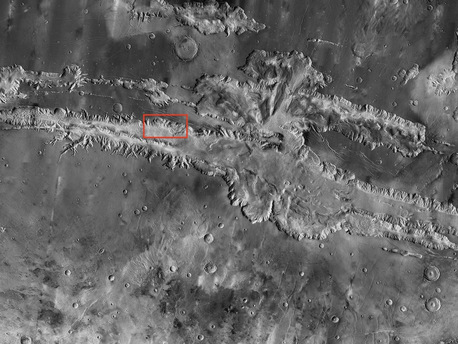Red Planet
NASA Spacecraft Camera Yields Most Accurate Mars Map
 © NASA/JPL/Arizona State University
|
Valles Marineris, the "Grand Canyon of Mars," sprawls wide enough to reach from Los Angeles to nearly New York City, if it were located on Earth. The red outline box shows the location of a second, full-resolution image.
The pictures have been smoothed, matched, blended and cartographically controlled to make a giant mosaic. Users can pan around images and zoom into them. At full zoom, the smallest surface details are 100 meters (330 feet) wide. While portions of Mars have been mapped at higher resolution, this map provides the most accurate view so far of the entire planet.
The new map is available at: http://www.mars.asu.edu/maps/?layer=thm_dayir_100m_v11 .
Advanced users with large bandwidth, powerful computers and software capable of handling images in the gigabyte range can download the full-resolution map in sections at: http://www.mars.asu.edu/data/thm_dir_100m .
"We've tied the images to the cartographic control grid provided by the U.S. Geological Survey, which also modeled the THEMIS camera's optics," said Philip Christensen, principal investigator for THEMIS and director of the Mars Space Flight Facility. "This approach lets us remove all instrument distortion, so features on the ground are correctly located to within a few pixels and provide the best global map of Mars to date."
"The Mars Odyssey THEMIS team has assembled a spectacular product that will be the base map for Mars researchers for many years to come," said Jeffrey Plaut, Odyssey project scientist at JPL. "The map lays the framework for global studies of properties such as the mineral composition and physical nature of the surface materials."
Other sites build upon the base map. At Mars Image Explorer, which includes images from every Mars orbital mission since the mid-1970s, users can search for images using a map of Mars at: http://themis.asu.edu/maps .
"The broad purpose underlying all these sites is to make Mars exploration easy and engaging for everyone," Christensen said. "We are trying to create a user-friendly interface between the public and NASA's Planetary Data System, which does a terrific job of collecting, validating and archiving data."
source: NASA
Red Planet
NASA Spacecraft Camera Yields Most Accurate Mars Map
 © NASA/JPL/Arizona State University
|
Valles Marineris, the "Grand Canyon of Mars," sprawls wide enough to reach from Los Angeles to nearly New York City, if it were located on Earth. The red outline box shows the location of a second, full-resolution image.
The pictures have been smoothed, matched, blended and cartographically controlled to make a giant mosaic. Users can pan around images and zoom into them. At full zoom, the smallest surface details are 100 meters (330 feet) wide. While portions of Mars have been mapped at higher resolution, this map provides the most accurate view so far of the entire planet.
The new map is available at: http://www.mars.asu.edu/maps/?layer=thm_dayir_100m_v11 .
Advanced users with large bandwidth, powerful computers and software capable of handling images in the gigabyte range can download the full-resolution map in sections at: http://www.mars.asu.edu/data/thm_dir_100m .
"We've tied the images to the cartographic control grid provided by the U.S. Geological Survey, which also modeled the THEMIS camera's optics," said Philip Christensen, principal investigator for THEMIS and director of the Mars Space Flight Facility. "This approach lets us remove all instrument distortion, so features on the ground are correctly located to within a few pixels and provide the best global map of Mars to date."
"The Mars Odyssey THEMIS team has assembled a spectacular product that will be the base map for Mars researchers for many years to come," said Jeffrey Plaut, Odyssey project scientist at JPL. "The map lays the framework for global studies of properties such as the mineral composition and physical nature of the surface materials."
Other sites build upon the base map. At Mars Image Explorer, which includes images from every Mars orbital mission since the mid-1970s, users can search for images using a map of Mars at: http://themis.asu.edu/maps .
"The broad purpose underlying all these sites is to make Mars exploration easy and engaging for everyone," Christensen said. "We are trying to create a user-friendly interface between the public and NASA's Planetary Data System, which does a terrific job of collecting, validating and archiving data."
source: NASA






